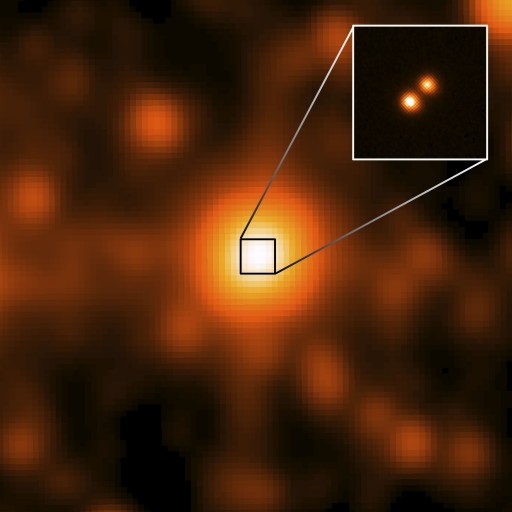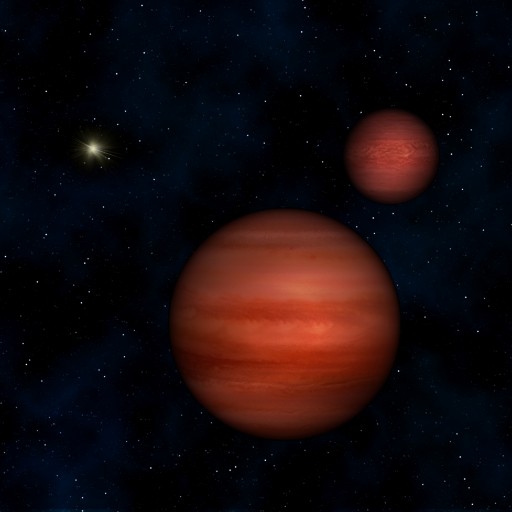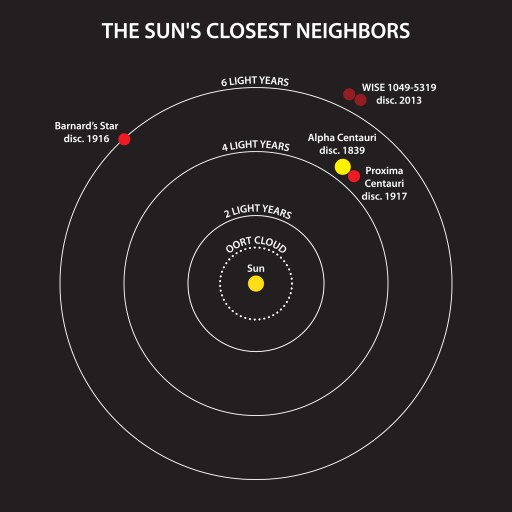The closest star system found in a century
March 14, 2013

WISE J104915.57-531906 is at the center of the larger image, taken by the WISE satellite. It appeared to be a single object, but a sharper image from Gemini Observatory revealed that it was a binary star system. (Credit: NASA/JPL/Gemini Observatory/AURA/NSF)
A pair of stars in the third-closest star system to the Sun has been discovered by an astronomer — the closest star system discovered since 1916.
The discovery was made by Kevin Luhman, an associate professor of astronomy and astrophysics at Penn State University and a researcher in Penn State’s Center for Exoplanets and Habitable Worlds.
The star system, named “WISE J104915.57-531906” (discovered in a map by the NASA-funded Wide-field Infrared Survey Explorer (WISE) satellite) is only slightly farther away than the second-closest star, Barnard’s star. It was discovered 6.0 light years from the Sun in 1916.
The closest star system consists of Proxima Centauri, at 4.2 light years, discovered in 1917, and Alpha Centauri, at 4.4 light years (discovered in 1839), and.
“The distance to this brown dwarf pair is 6.5 light years — so close that Earth’s television transmissions from 2006 are now arriving there,” Luhman said. “It will be an excellent hunting ground for planets because it is very close to Earth, which makes it a lot easier to see any planets orbiting either of the brown dwarfs.”
Since it is the third-closest star system, in the distant future it might be one of the first destinations for manned expeditions outside our solar system, Luhman said. (That expedition could be the planned 100 Year Starship.)
Both stars in the new binary system are “brown dwarfs,” which are stars that are too small in mass to ever become hot enough to ignite hydrogen fusion.As a result, they are very cool and dim, resembling a giant planet like Jupiter more than a bright star like the Sun.

This image is an artist’s conception of the binary system WISE J104915.57-531906 with the Sun in the background (credit: Janella Williams/Penn State)

This diagram illustrates the locations of the star systems that are closest to the Sun. The year when each star was discovered to be a neighbor of the Sun is indicated. (Credit: Janella Williams/Penn State)
By combining the detections of the star system from the various surveys, Luhman was able to measure its distance via parallax, which is the apparent shift of a star in the sky due to the Earth’s orbit around the Sun.
He then used the Gemini South telescope on Cerro Pachón in Chile to obtain a spectrum of it, which demonstrated that it had a very cool temperature, and hence was a brown dwarf.
“As an unexpected bonus, the sharp images from Gemini also revealed that the object actually was not just one but a pair of brown dwarfs orbiting each other,” Luhman said.
“It was a lot of detective work,” Luhman said. “There are billions of infrared points of light across the sky, and the mystery is which one — if any of them — could be a star that is very close to our solar system.”
This research received financial support with a grant from the NASA Astrophysics Data Analysis Program.